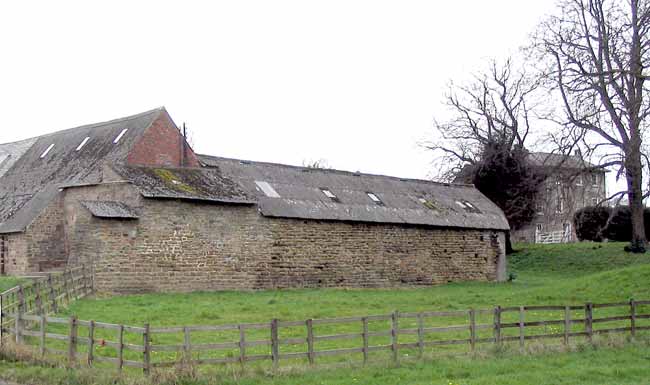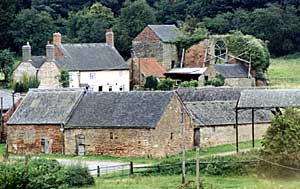The Castle

Ditch and bank around outbuildings at Greasley Castle Farm may indicate the remains of a moat (photo: A Nicholson, 2004).
Nicholas, Baron Cantelupe, was a warrior who after fighting for Edward II and Edward III in Scotland and France and serving the latter in many high offices experienced little difficulty in obtaining permission to transform his mansion here into a strong-hold with a defensive moat. It must have been more than an embattled house for surviving walling displays masonry five feet thick and of great strength, and yet visible earthworks indicate an elaborate system of ramparts: its obvious purpose was to combine security with comfort.
There is no record of the castle ever sustaining a siege, though a local tradition has it that it was taken and overthrown during the 17th century Civil War when affrays between Cavaliers and Roundheads in this district certainly took place. The scene would be martial enough when its Zouch owner in 1485 marched out with his retainers to fight for Richard III at Bosworth Field. Mary Eyre's tapestry map of 1632 depicts it as a grim fortress, and Thoroton's statement that it was thoroughly destroyed by 1677 may mean that it had been seriously damaged in the recent wars, but it appears to have been habitable in diminished form at the opening of the 18th century. To the Transactions of the Thoroton Society for 1934 Mr. Herbert Green contributed an illustrated account of experimental excavations made under his supervision which disclosed some interesting discoveries, and Mr. Wm. Stevenson's brief description in the Victoria County History of the remains as he saw them 40 years ago is embellished with a plan.
The Priory

Beauvale Priory (photo: A Nicholson, 2004).
Although Beauvale Priory was erected in Greasley Park and within a mile of its founder's castle it stood in the Watnall portion of the parish and its consideration is accordingly reserved until Watnall is reached in this series but there are some Greasley details demanding present notice. It was at Greasley on December 9th, 1343, in the presence of an august assemblage of prelates and nobles that Nicholas, third Baron Cantelupe, executed the foundation charter of this Carthusian priory for twelve monks, bestowing upon it his park with messuages, lands. rents, and services of villeins here and elsewhere. A further gift in 1347 included more of this vill, and among other benefactions was that by Wm. de Aldburgh of the Hay of Willay in 1362. The full details of Cantelupe's foundation grants appear in vol. VI. the Thoroton Society's Record Series where they occupy several pages. The priory was suppressed in 1539 and some picturesque fragments of the building yet remain.
UPON the death of the priory founder in 1355, his brother Richard took possession of Ilkeston and Greasley, with the castle and its appurtenances, consisting of 13 cottages, 300a. of land. 20a. of meadow, 200a. of pasture, 1,009a. of wood, and rentals amounting to £10, all of which should have passed to the widow, who at the Nottingham Assizes in 1356 proved that an alleged deed of gift by her was a forgery. The transgressors were cast in heavy damages. By 1355 Greasley was in the possession of the founder's grandson, who complained that "Ralph Paynel and others broke into his castle of Greasley, ravished Katherine his wife and carried her away with his goods and chattels, which they still detain from him." An inquiry was ordered, but its findings are unknown.
The last of the Cantelupes dying without issue in the reign of Richard II, his manor and castle of Greasley descended to a relative, Wm. de la Zouch, and remained with his descendants for a century. "In 1485, they were forfeited by Lord Zouch, who had fought for Richard III at Bosworth, and were granted by Henry VII to Sir John Savage" for services rendered," and presently when Sir John and his son were convicted of the murder of John Pauncefote they escaped with a fine of 4,000 marks to be paid by instalments, Greasley and other possessions of theirs being held as security for payment.
In 1414, the canons of Felley released to Beauvale Priory the tithes at Willay which the parson of Greasley had vainly claimed in 1305, and in 1534 Lenton Priory was drawing 6s. 8d. yearly from Greasley tithes. Local tradition tells that the penultimate prior of Beauvale laid a curse upon a woman for declining to bequeath land here (Molly Mill's Field) to his priory, whereupon the lady cursed him back and foretold his death upon the gallows. In 1535 he was hanged with the prior of the London Charterhouse for refusal to acknowledge Henry VIII as Supreme Head of the English Church.
An entry in the "Letters and Papers of the Reign, of Henry VIII" (containing numerous field-names) records that in 1541 Sir Wm. Hussey, of London, purchased Beauvale Priory with its possessions here, &c., but 1550 all these were transfered for £1,685 5s. 10d. to Sir Rd. Moryson and his heirs.
The annals of the parish during the next 150 years are largely concerned with religious troubles and the war that grew out of them. The vicar who was appointed in 1544 seems to have moved with the times, and held the living until he died in 1570. In 1552 it was.found that a church bell had been improperly sold for £10, and a few years later the chancel was reported to be in decay, but it accommodated a school whose master when forbidden so to use it forced its door and after an altercation with the parson assaulted him and drew blood, for which he was excommunicated. The unfortunate vicar was Elias Okedene, who was cited for conducting public worship without a surplice and for omitting evening prayers on festival days. His successor was ordered to be suspended for three years for marrying Lancelot Rolleston, Esq., in Greasley Church at 4 o'clock in the morning and that without publishing the banns, but after two month his sentence was relaxed.
A more significant marriage was that of John Robinson, the famous pastor of the Pilgrim Fathers, who in 1603 wedded Bridsett, a member of the Sturton family of Whites of whom a branch were lessees of the Castle Farm. A generation later this was probably associated with the Roundhead colonel, Chas. White of whom Lucy Hutchinson wrote so disparagingly though her fairness is not above suspicion. Puritanism was rife in the parish; in 1631 the recalcitrant churchwardens were commanded to restore the pulpit to the place from which it had been removed, and in 1638 the vicar was called to account for "nonconformity in administering the Sacrament to strangers, for not wearing the surplice, and for not using the sign of the Cross in baptism"
Meanwhile, important secular changes had taken place and the Civil War was casting its shadows before it. About 1608 Sir John Manners brought the manor to the Rutland's by purchase; the properties of the Morysons had descended by marriage to Lord Capel, and the war found Greasley's owners divided in their allegiance. The Earl of Rutland, Colonel White and Gilbert Millington were Parliamentarians, as also was Robt. Smalley, the Presbyterian Minister who suffered ejection in 1662. Capel was one of the king's chief supporters, who after capture escaped from the Tower, was recaptured and beheaded a few weeks after the execution of Charles I. His Notts estates were seized by the County Committee, "notwithstanding a grant to the contrary," but after inquiry the "rents from Greysley and other places in the county" were restored to his widow, the Moryson heiress. The 1st Duke of Newcastle had some land here which was sequestrated but compounded for in 1652.
